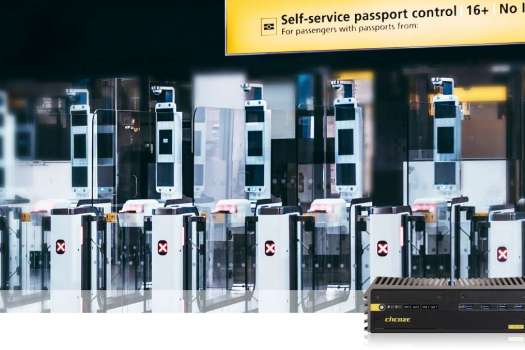Airport accelerates e-Gate with Cincoze Industrial Computer
Shuffling down the long, snaking queue to border control is an unpleasant and, until now, an unavoidable rite of passage for international travelers. Even if the duty officer manages a lighthearted witty comment to ease the tension, the long wait is something we’d all rather avoid. That’s where e-Gates come in. They increase security and speed up border control.
Cincoze’s client is a major European multinational enterprise providing solutions to bolster safety and efficiency in security, transportation, aerospace, and defense. They helped an international airport in Southwest Europe to improve customs efficiency and optimize the passenger travel experience by integrating the Cincoze MXM GPU computer (GM-1000) into the airport’s e-Gate rapid customs clearance system. The computer is the central control system and must scan passports, control gates, and connect to the database for facial recognition and comparison. It enhances security while reducing customs clearance times and manpower costs.
Product Requirements

Computing power and size
The industrial computer needs to process face and fingerprint images in real time and connect to the database for verification, so excellent computing performance is the primary requirement. The ideal configuration includes a high-performance CPU and discrete GPU card to ensure fast and accurate data processing. Due to the limited installation space in the e-Gate equipment, a small computer is required.
Various peripheral connectors
Multiple peripherals are needed to perform various tasks, including scanning passports, controlling gates, displaying operating procedures, photographing faces, scanning fingerprints, and connecting to databases. The industrial computer must have rich I/O interfaces to connect to these various peripherals.
24/7 long-term operation
The airport is open 24/7 and there are sweltering high temperatures to contend with in the enclosed installation environment. The industrial computer must have a rugged design to ensure long-term stable operation and reduce breakdowns and maintenance.
Why Cincoze?

The compact GM-1000 (260 x 200 x 85 mm) supports workstation-grade Intel® Xeon® CPUs and MXM 3.1 Type A/B GPU modules, including a variety of NVIDIA embedded GPU modules. This configuration can easily cope with the computing and processing needs of large-scale real-time facial recognition in the e-Gate system. The system supports power consumption of up to 360W, ensuring reliable operation of the CPU and GPU.
The GM-1000’s rich native I/O, coupled with the exclusive CMI expansion module, meets the e-Gate’s serial connection needs for peripheral devices. High-speed I/O includes 10GbE LAN and 1GbE LAN, which facilitates connection with high-speed cameras to transmit a large number of real-time facial images. The passport and fingerprint scanner connect through USB 3.2 Gen2 or COM. Operating steps are shown on a display connected to the DVI, DisplayPort, or HDMI ports. Connection with the data center is handled through a wired or wireless network. Such a rich I/O interface provides a high degree of flexibility.
The GM-1000 has industrial protection mechanisms that ensure long-term stable operation, such as wide temperature (-40 to 70°C) and wide voltage (9 to 48 VDC) support, shock and vibration resistance (5/50 Grms), and overvoltage, overcurrent, and ESD protection. In order to support the stable operation of the CPU and GPU at the same time, the GM-1000 is equipped with a special heat dissipation design to provide stable performance even in hot environments. An external fan is also available as an option to further enhance cooling.
Cincoze industrial computers use a consistent design across generations to ensure flexibility for future expansion. Products in the same series have the same volume, size, and locking hole positions, so customers do not need to redesign the mechanism when upgrading to next-generation products. Another advantage is the high compatibility of the modules. If the GM-1000 needs to handle more complex tasks in the future and requires enhanced GPU performance needs to be increased to cope, it can be seamlessly upgraded by simply replacing the MXM module and carrier board, protecting the value of existing equipment investments.

